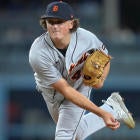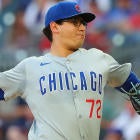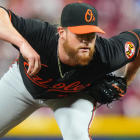Yesterday, I took a look at which batters have showcased the best raw power in baseball this season, by looking at the historic relationship between home run per fly ball and hard-hit percentage. As it turns out, there is an intuitive and clear relationship between these two traits for hitters; the more hard-hit balls a batter produces, the more likely his batted-balls are to go over the fence.
I decided to look at the same information for pitchers today, all of which is available at FanGraphs.com. If the relationship was so clear for hitters, it would make sense that it might hold true for pitchers as well:

Well, that doesn't really seem to tell us much of anything. Among qualified starters from 2011-15, how often hard contact is allowed doesn't really say much about how often that pitcher will allow home runs. You have some players, like Joe Blanton or Samuel Deduno, who get hit hard more often then average and also see a higher share of their fly balls soar past the fence, which makes sense.
However, Shelby Miller, the pitcher who has given up the most hard contact among the 187-player sample size in that time, actually allows home runs at a slightly lower rate than the average. Alternately, the ability to induce tons of weak contact doesn't really tell us anything about a pitcher's home run suppression abilities; Jered Weaver has shown the ability to keep the ball in the park while inducing a ton of weak contact, while Dallas Keuchel has allowed 13.7 percent of his fly balls to go over the fence despite having the fifth-lowest hard-hit average.
There are a few explanations for why these results come out this way, and they can help us understand why defense independent pitching stats like FIP can be so useful for pitchers. First off, it seems hitters just have much more control over how hard their batted balls are hit than pitchers are.
There is much more variance in both HR/FB and hard-hit rate among hitters than pitchers, with many more players operating at the extremes, probably because there is so much more variance in the skill levels. Some pitchers certainly appear to have the ability to induce weak contact, but it just doesn't seem to be as important to their success as for hitters.
Another part of why so few pitchers stand out in these stats is that they are facing a much more diverse skill set. While one batter might face two or three pitchers in a given game, each starting pitcher to face at least nine different hitters, assuming he can get through the order once. Because they are facing so many different types of hitters, whatever the pitcher's skill is won't be able to stand out as much.
This is one instance where I set out with a conclusion in mind only to have the research rebut it. Unlike yesterday, it isn't quite so easy to say who might be benefitting from a bit of homer luck and whose raw power suggests the ability for more. In this instance, we have to look to other places for potential outliers.
That doesn't mean batted-ball data isn't useful for analyzing pitchers. You obviously want to target pitchers who induce a lot of groundballs, and pitchers who don't allow a lot of balls to be pulled generally do allow fewer home runs per fly ball, though that isn't a huge indicator either. Still, we know pitchers can, to an extent, induce batted balls to certain spots, and you can find significant there.
If you're looking for the best buy-low or sell-high candidates at pitcher, your best bet is still to look at who is most underperforming or overperforming their FIP and xFIP and go from there.





















